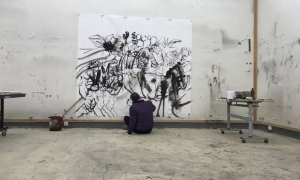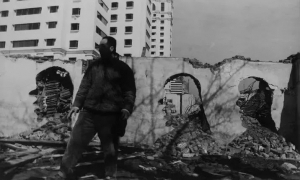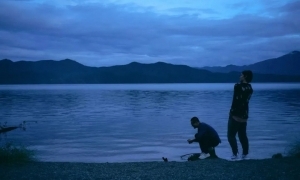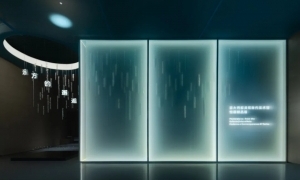打破传统的展览
马腾•贝尔特(阿姆斯特丹)
导论
从为数众多的国际展览来看,当前的艺术展览实践源于19世纪。“落选者沙龙”(Salons des Refusés)展出了那些被皇家绘画和雕塑学院(Académie royale de peinture et sculpture)拒绝的作品,后者以一种苛刻和保守的标准对艺术家的作品进行审查。像“落选者沙龙”这一类展示进步艺术的展览的出现,标志着一种重视独立和创新的展览体系的形成。在整个20世纪的进程里,许多引发争议的展览都带来了新的观点。这些展览有的在博物馆中举行,但大部分处于博物馆体制之外,因为博物馆的价值观反对任何引发争议的展览。
“现实主义亭”并不自称为一种全新的展览理念的产物。本展览展出一些不受民族主义意图和现存惯例影响的艺术家的作品。在上海世界博览会的各种官方和半官方展览,以及北京艺术节的商业展览的包围中,本展览为上述艺术家提供了一个展示的舞台。在这样的背景下,有必要在这里讨论历史上的一些重要展览,在这些展览中艺术家都试图打破当时存在的传统。
“落选者沙龙”(Salons des Refusés)和库尔贝(Courbet)的《画室》(L’Atelier)
在1863年,拿破仑批准举办一个展览,专门展出那些被皇家绘画和雕塑学院拒绝而无法在官方沙龙中展出的作品。当年在所有参选作品中有近百分之三十被官方拒绝参展,这个比例创当时的历史新高。在被拒绝的艺术家中包括保罗•塞尚(Paul Cézanne)、詹姆斯•麦克尼尔•惠斯勒(James McNeill Whistler)、皮埃尔-奥古斯特•雷诺阿(Pierre-Auguste Renoir)、卡米尔•毕沙罗(Camille Pissarro)和爱德华•马奈(Édouard Manet)。马奈的《草地上的午餐》(Le déjeuner sur l’herbe)受到如潮的批评 。“落选者沙龙”和官方沙龙在工业宫(Palais de l’Industrie)的大厅中同台展出,虽然受到评委会和很多艺术批评家的一致批评,但也吸引了一些进步作家和批评家。当时官方沙龙评委会最青睐历史题材的绘画,但“落选者沙龙”使人们开始意识到在历史题材绘画以外,新近创作的艺术具有更加宽广的风格和体裁。同时“落选者沙龙”也催生了对被拒绝的作品进行评判的公共话语,这在各方面都带来了热烈的反应。作为一个有趣的后果,很多遭拒绝的艺术家出人意料地在第二年被官方沙龙接纳了。
艺术家出于对学院保守趣味的不满而组织的展览不仅仅只限于1863年的“落选者沙龙”。1885年的巴黎世界博览会(官方全称是1855年巴黎农业、工业和艺术产品世界博览会[Exposition Universelle des Produits de l’Agriculture, del’Industrie et des Beaux-Arts])组委会提出为居斯塔夫•库尔贝、欧仁•德拉克洛瓦(Eugène Delacroix)和让-奥古斯特-多米尼克•安格尔(Jean-Auguste-Dominique Ingres)举办个人作品展。巴黎世界博览会的评审团也是由学院派组成的。库尔贝和德拉克洛瓦都反对学院派。部分出于对自己的大作《画家的工作室》被拒绝的不满,库尔贝拒绝了官方展览的邀请,并自己组织了展览。
这件被拒绝的绘画的全称是《画家的工作室——真实的预言,我七年艺术和道德的总结》(L’Atelier du peintre, allégorie réelle, déterminant une phase de sept années de ma vie artistique)。这件作品对其时代进行了艺术性的陈述和文献记录。通过作品中一幅正在创作中的现实主义绘画,这件作品表达了库尔贝自己对现实主义的理解。裸体的女人代表不加掩饰的真理,小孩代表纯洁和清白。在画中场景的左边,他安排了街上常见的人物形象,包括一个牧师,一个流浪者和一个猎人。在场景的右边他描绘了他的作家朋友,如查尔斯•波德莱尔(Charles Beaudelaire), 乔治•桑德(George Sand)和尚弗勒里(Champfleury),哲学家皮埃尔-约瑟夫•蒲鲁东(Pierre-Joseph Phoudhon),以及他的朋友和赞助人阿尔弗雷德•布吕亚(Alfred Bruyas)。在《画室》中库尔贝构造了一种社会语境,从而符合了波德莱尔对艺术家提出的要求,即艺术家应该报道自己生活在其中的时代,而不要对历史和现实进行一种浪漫主义或理想化的重构。波德莱尔的这个信条对以库尔贝为核心的现实主义运动和19世纪60年代和70年代以马奈和巴蒂诺尔团体(Batignolles group)为核心的艺术运动提供了理论支撑,并在某种程度上影响了20世纪的现实主义运动 。
1915年在列宁格勒举行的最后一次未来主义绘画展“0.10”,杜尚(Duchamp)在1938年“巴黎超现实主义展”中的介入行为(intervention),以及1942年纽约的“超现实主义最初文本展”。
“0.10”(零——十)展被称为“最后一次立体—未来主义展”,展出了卡基米尔•马列维奇(Kazimir Malevich)三十件非具象绘画,以及其他九位艺术家的作品。马列维奇本想把这些作品称为至上主义,但是遭到了包括弗拉基米尔•塔特林(Vladimir Tatlin)在内的其他艺术家的反对。只有I.V.克莱文(I.V. Klyun)和M.I.缅科夫(M.I. Menkov)支持马列维奇的至上主义 。在一封写于1915年5月29日的信中,马列维奇表示他想“从零”开始,这就是该展览标题的来源。具体的说,他想把具象绘画带回零点并超越零点——进入非具象的领域。马列维奇的49件绘画作品悬挂在各式各样的墙面上,而他那件有黑色正方形的绘画则高高挂在空间的角落,这通常是悬挂俄罗斯圣像的地方。马列维奇用白纸覆盖了所有的墙面,这样的他绘画中的抽象形式就像悬浮于某种统一的白色背景之上,就像他在绘画中试图取得的效果一样。通过这种方式,他取消了所有和现实世界有观念的物品。马列维奇感兴趣于通过抽象的形式和颜色达到纯粹的视觉效果的表达。他为抽象艺术设定的白色展墙成了后来“白盒子”展览方式的原型,这种展览方式意在将艺术品置于一个与世无涉的纯粹展示空间中,并突出艺术的纯粹性。
和上述“白盒子”的理念截然相反,杜尚在分别举行于巴黎和纽约的两次超现实主义展览期间的介入行为显示了另一种理念。超现实主义创始人安德烈•布雷东(André Breton)邀请杜尚为展览设计介入行为,以便强化 “巴黎超现实主义展”中超现实的特征。在展场的大厅中,杜尚设计了一条“超现实主义大街”,其中布置着20个穿着不同艺术家设计的衣服的模特模型,各个模特身后墙上挂着街道的标记。通向最大展厅的通道被改造为古怪的洞穴。顶上挂着隔离光线的口袋,地上覆盖着树叶,蕨类和草,经过烘焙的咖啡豆散发出强烈的芬芳。在入口处,曼•雷(Man Ray)向观众分发手电,以便他们能在展场微弱的光线中观看作品。观众的反应是震惊的。但是杜尚在展览开幕的时候却坐火车去了伦敦 。杜尚还为1942年纽约举行的“超现实主义最初文本展”设计了另一件介入行为。他用白色麻线在展览空间的入口处织了一个网,用这种简单的手段取得了最大的效果。总共长达1600米的麻线织成的网使展览空间入口完全被封闭。在开幕期间杜尚还让小孩剪掉一些线团并在里面玩耍。真正的观众又一次陷入困扰之中,杜尚也在展览开幕期间再次缺席 。
马塞尔•布达埃尔(Marcel Broodthears)和伊夫•克莱因(Yves Klein)
在某种意义上,布达埃尔和克莱因可以被视为在第二次世界大战之后杜尚和马列维奇的传人。布达埃尔的作品和表现形式受到杜尚和超现实主义的影响,也在形式和内容上显示出与波普艺术和观念艺术相似的特征。最初布达埃尔是个不成功的诗人,后来他把几本自己未售出的诗集《思考—野兽》(Pense-Bête)部分封装在石膏中并置于底座上展览,因此转型成为视觉艺术家。上述作品是他探讨文本和图像,语言和现实之间界限的开端。在1968年他在布鲁塞尔的家中成立了《现代艺术博物馆,鹰部》(Musée d’ Art Moderne, Departement des Aigles)。他展出了艺术品的包装箱和19世纪装框绘画的复制品,并在给友人的信中自称为这个机构的主任。鹰象征机构权威带来的界定艺术品权力,主任代表全能的运作者,就像19世纪沙龙的评审团一样。在杜塞尔多夫,他展出了同样的作品,并加上了副标题:“马塞尔•布达埃尔的实验性展览,来自他的现代艺术博物馆,鹰部,肖像处”(Marcel Broodthears montre une esposition expérimentale de son Musée d’Art Moderne, Département des Aigles, Section des Figures)。布达埃尔想表达的是,在这个展览模式的实验中,他使用了一种高度等级化的体系。通过这种反讽的行为和鹰带来的象征,布达埃尔向观众展示了决策过程,以一种杜尚式的方式对决定“伟大艺术”的权威进行揭露。在展览中他也表明,19世纪的沙龙展,当代的文献展、双年展和全球艺术市场并不单纯是对艺术创作进行鼓励,同时还被用来提升城市的形象,服务于文化娱乐和市场营销的目的。
对于伊夫•克莱因来说,借助艺术能够达到对绝对和无限(在这方面他提到马列维奇)的体验。同时,他让浑身沾满涂料的裸体女模特在白色画布上留下痕迹,通过这种在公共场合进行的轰动一时和充满噱头行为艺术,他展示了自己对“神秘艺术”这种观念所持的讽刺态度。借用这种方式,他指挥了艺术作品的创作,而自己连画笔都不用摸一下。他的蓝色单色绘画(I.K.B.是“国际克莱因蓝”[International Klein Blue]的缩写)首次于1955年在巴黎展出。这是一件指向精神和对无限的体验作品。他把蓝天视为自己最伟大的艺术品。在此之后他又创作了金色(象征绝对)和粉红色(象征生活)的单色绘画。在1958年他组织了一场展览,展览现场空空如也,只有艺术家本人在场。克莱因称之为“非物质绘画感受空间”(zones de sensibilité picturale immatérielle)。这种超验的感受概念是他艺术和作品的核心思想。克莱因这样对其进行定义:“超越我们的存在,但又总是存在于我们之中” 。通过把空无提升为一种隐形的绘画环境,观者进入一种狂喜的状态,并产生一种情感体验。展出的艺术品不再是理念的承载工具——相反,空无带来了一种对于无限的神秘和解放的体验。但观众和批评家的愤怒反应说明他们还不习惯于积极地参与这种体验。
展览链接:
1968年前后
在1968年前后出现了一波创新潮流。这个时期出现了新媒体,同时人们的观念发生转变,不再认同艺术体制中占统治地位的自治艺术的灵韵和独特性的观念,以及艺术品作为美学和市场的物品的观念。街头艺术、偶发艺术和行为艺术、情景主义、通过观念使艺术品去物质化,以及大地艺术补充了博物馆艺术的单一面貌。
激浪派艺术家寻求建立日常生活和艺术之间的关系。约翰•凯奇(John Cage)和白南准(Nam June Paik)把观众的注意力引向真正街头的声音。沃尔夫•福斯特尔(Wolf Vostell)在街头向路人高声朗读词语和信件片段,以达成社会互动。约瑟夫•博伊斯(Joseph Beuys)在他魔幻和引人深思的行为表演中扮演一种通灵者的角色。在1969年,贫困主义艺术家贾尼斯•库内尼斯(Jannis Kounellis)在罗马的皮亚特里(Piatelli)画廊展出了十匹活马,把艺术和自然诗意地联系起来。丹尼尔•布伦(Daniel Buren)在街上进行艺术创作,用竖条纹白彩布装饰住宅,墙面和公示栏,以便躲避策展人的干涉。温河原(On Kawara)从世界各地寄出明信片,上面写着“我于…点起床”,每张明信片上写的起床时间各不一样。吉尔伯特和乔治(Gilbert & George)在他们的行为表演中发明了活雕塑的概念,使用自己的身体在自然和日常生活之间建立联系。理查德•朗(Richard Long)从行走出发,踩倒一片草地,或用捡的石头和树枝制作雕塑。所有这些艺术、行为和观念显示出一种不同于已经建立的艺术实践的新态度。
苏联和巴西1968年前后的政治艺术
在那些政治氛围不允许独立艺术创作的国家中,艺术家用各种方法逃避官方的审查。这使他们发展出独立于官方体制的展示方式。在苏联,艺术家被迫加入艺术家协会,创作社会主义现实主义的作品。这使艺术家在1960年至1986年间不得不进行秘密的展览,行为表演和各种活动。为了防止观众中混入告密者,展览往往在艺术家的公寓中,或者在城市外的露天演出举行。在后斯大林时期,非官方艺术家主要针对理想社会的失败创作反讽和批判的艺术,这和官方艺术对社会主义的歌功颂德形成对照。非官方的艺术作品故意描绘那些生活中的缺陷和更加贴近现实生活的社会主义人(homo sovjeticus),而不是空洞的英雄主义故事。因为这些艺术作品不可能出售,艺术家意在使其在短短的一段时间内具有某种功能,因而使艺术品成为“无价值”和短暂的建构。在绘画中主要是借鉴告示牌上常见的符号、陈词滥调和标语,并巧妙地加以处理,使明眼人一下就能看出其中隐含的指涉和讽刺。这种“社会主义艺术”(Sots Art)的代表之一是伊利亚•卡巴科夫(Ilya Kabakov)。他的作品描绘了居住在小公寓中的社会主义人的悲惨生活。比如,装置作品《从公寓飞向太空的人》展示了一个凌乱的室内场景,中间放置着一个发射器,一个人通过天花板上的洞被发射到外太空乌托邦中。
和苏联的情况类似,在南美洲军人执政的国家中,前卫艺术家也试图通过艺术批判国内的政治状况。在这些国家中艺术家也组成地下团体,在秘密地点进行偶发艺术和观念艺术的创作,以逃避官方的审查。在巴西,前卫艺术发展迅速,部分原因是创办于1952年的圣保罗双年展使巴西和国际艺术世界频繁接触。马克思•比尔(Max Bill)的具体艺术(concrete art)尤其引起进步艺术家团体的反响。在艺术家沃德玛•卡尔德罗(Waldemar Cordeiro)领导下的圣保罗断裂团体(Ruptura group)创作了纯粹具体和主要是非具象的艺术。在里约热内卢,艺术批评家马里奥•佩德罗萨(Mário Pedrosa)和费里拉•古拉尔(Ferreira Gullar)倡导了一种更加富有诗意和直觉的具体艺术形式,这种艺术面向和空间的逐渐融合。该运动的主要代表是利吉亚•卡拉克(Lygia Clark)、何里欧•奥蒂塞卡(Hélio Oiticica)、利吉亚•佩普(Lygia Pape)和威利斯•德•卡斯特罗(Willys de Castro)。巴西艺术世界的创新运动被1964年军事政变中断,新上台的政府对艺术实行严格的审查制度。在这个事件之前,社会上就艺术和社会的关系产生了争论。费里拉•古拉尔在50年代支持艺术的自治价值,在1963年他撰写《质疑文化》(Cultura posta em questão)一文,描述了一种现象,即在所有的精英艺术中,美学价值被视为比意识形态更加重要的问题。他呼唤一种强调观众参与的艺术,抨击缺乏社会或革命功能的艺术,并呼吁培养巴西贫民区、工厂和大学中的流行文化。何里欧•奥蒂塞卡并不是一个热情的政治参与者,但是他也持类似的观点。他是一位热诚的桑巴舞者,大部分时间都生活在贫穷的曼格拉山(Mangueira Hill)地区。他举行公开的集会,邀请来自贫民区的观众穿着他设计的像斗篷或批巾的帕拉贡勒斯(parangolés)行走或跳舞。这种彩色的布具有不同的形式,是对他之前的几何抽象实验的一种延续。两者的区别在于,后者融合了集体、社会和个人的身体的参与,而这在他早先的构成主义作品中是看不见的。
其他对抗政权的艺术家为物品或绘画赋予更加颠覆的含义。切尔多•马雷莱斯(Cildo Meireles)就是这样一位艺术家。他在1970年制定了政治艺术计划《插入意识形态循环》(Insertions into Ideological Circuits)。通过在钞票和可乐罐子上印刷图像和语句,他使这些流通中的有价值物品不再可能被损坏。这个计划一直持续到1976年。马雷莱斯还以其他方式发挥钞票的主题,自己制作了钞票和硬币复制品(1974到1978年),这些复制品和巴西和美国的真钞和硬币非常相似,但是面值都为零,比如《零美元纸币》(Zero Dollars)。这些策略都是为了使官方体制外的观众参与进来,并代表一种反对军事政权的政治声明。这里值得指出,军事政权允许并支持几何抽象艺术,还委托雕塑家进行公共艺术的创作,因为这种“价值无涉”的艺术至少在政治层面上不构成任何危险。
当前的发展
1968年那一代艺术家对当前最新一代艺术家产生了巨大的影响。这些艺术家质问自己艺术是如何发挥作用的。对于艺术发生的场域的讨论也仍在继续。新一代艺术家身处后现代时期,质疑现代主义前卫艺术的进步观点,并探讨西方文化的主导地位。批评家托马斯•麦克艾维利(Thomas McEvilley)这样说道:“现代主义通过对基督教传教士的热情进行一种帝国主义的重新定义,强加了一种永恒的自我特征;后现代主义对自我和历史采取一种更加多面和变动的感知,不规定一种固定的身份和方向。” 这带来了新的可能性,既存的规范开始逐渐改变。艺术家同意现代主义并不能自动带来新的乌托邦,在大部分情况下艺术并不能完成这种任务。但是这种认识的存在并不意味着所有艺术家都放弃了改造社会的努力。艺术家们仍然继续探讨确立艺术和社会之间的关联的可能性。在90年代,艺术家里克里特•特拉万尼加(Rirkrit Tirivanija)让观众参与到他构建的环境中,从而带来一种新的互动的形式。他为观众提供食物,创造各式休闲活动,并寻求和其他艺术家和学生合作的可能。通过这种活动,他的装置作品的形式得到持续更新。自从2003年以来,特拉万尼加开始了他的《大地》计划,在该计划中他和来自不同国家不同背景的人合作,共同开发一块土地。该计划赋予现代主义以新的含义,并在私人和公共,局部和全球的领域中建立起关联。
出生于比利时的艺术家弗朗西斯•埃利斯(Francis Alÿs)主要在墨西哥城工作。他的作品综合了绘画、装置和介入行为等形式。这些介入行为是和参与者合作完成的,并以文献的形式记录下来。埃利斯通过对古希腊“城邦”一词的解释,描述了赋予他作品政治色彩的语境:城市是一个感知和斗争的场域,它释放出各种物质,进而带来创造、艺术和都市神话。他把自己视为波德莱尔笔下那种浪荡子的形象,以一种局外人—观测者的视野来观察城市。在一个介入行为作品中,他站在一名求职者身旁,并自称是墨西哥城的游客。在另一个更加诗意—政治化的行动中,他让基韦斯特、迈阿密和哈瓦那的渔民把渔船连接起来,从而搭建一个浮桥联通古巴和美国。这个行动真的被付诸实施,但是连接古巴和美国的浮桥并不需要真正搭建起来。整个过程以文献的形式记录下来。同样重要的是,这个介入行为取得了一种神话的效果,在社会中一传十,十传百。重复、最大努力和最小效果是他的作品中反复出现的主题。重复使一件作品永远无法完成,只能以过程或概念策略的形式存在。他用这种方式和现代主义艺术拉开距离。在现代主义艺术中最终的作品被视为评价的前提。
埃利斯和特拉万尼加是为介入行为和参与生活的艺术概念赋予新定义的艺术家代表。他们延续了非传统艺术的表达方式,但在介入行为和展示呈现中使观众重新思考艺术的角色。
马腾•贝尔特, 2010年4月
展览链接:
Exhibitions That Stirred Conventions
Maarten Bertheux(Amsterdam)
Introduction
The current practice of exhibiting art, offering a large number of international exhibitions, has its roots in the nineteenth century. The Salons des Refusés presented the work of artists who had been rejected by the severe and conservative selection of the Royal Academy of Painting and Sculpture (Académie royale de peinture et sculpture) in Paris. Such exhibitions of progressive artists are considered the start of a development where exhibitions demonstrate independence and creativity. Over the course of the twentieth century, provocative exhibitions were manifestations of new viewpoints. These exhibitions sometimes were held in museums, but just as often outside of them, because the museums often cling to values that stand in the way of controversial presentation. The Pavilion of Realism houses the work of artists that are free of nationalistic intent or existing conventions. It offers a podium for their work within and adjoining the many official and semi-official exhibitions of the World Exhibition in Shanghai and the commercial exhibitions of the Art Fair in Beijing. Against this background, it is interesting to present some examples of exhibitions in which artists have countered existing traditions.
De Salons des Refusés and Courbet’s l’Atelier
In 1863, by mandate of Napoleon III, an exhibition was organized of artists that had been rejected by the jury of the Academy for the official Salon. The adjudication was so severe that year that 30 percent of the entries were denied admittance. Among the many rejected artists were Paul Cézanne, James McNeill Whistler, Pierre-Auguste Renoir, Camille Pissarro, and Édouard Manet, whose “Luncheon on the Grass” (Le déjeuner sur l’herbe) had brought a flood of criticism1. The Salon des Refusés was exhibited in the same hall of the Palais de l’Industrie where works of the official Salon were shown and along with the criticism of the jury and various art critics, there was also appreciation from a more progressive group of writers and critics. The Salon des Refusés led to awareness that in addition to history paintings, which could count on the most appreciation from the Academy jurors, other art was being created which was broader in style and genre. It was also the beginning of a public discourse on the quality of the rejected art. In many cases the reactions were vehement. The curious result of all this commotion was that in the following year many of the rejected artists were unexpectedly admitted to the official Salon.
The Salon des Refusés of 1863 was not the only instance of artists organizing their own exhibition out of dissatisfaction with the conservative views of the Academy. One-man shows were offered to Gustave Courbet, Eugène Delacroix, and Jean-Auguste-Dominique Ingres during the World Expo (Exposition Universelle des Produits de l’Agriculture, del’Industrie et des Beaux-Arts) in 1885. Here, too, members of the Academy were on the jury. Both Courbet and Delacroix opposed the Academy and Courbet ignored the invitation, partly because his magnum opus l’Atelier du Peintre had been rejected, and organized his own first one-man show. The full title of the painting was L’Atelier du peintre, allégorie réelle, déterminant une phase de sept années de ma vie artistique [The Artist's Studio, a Real Allegory of a Seven-Year Phase in My Artistic and Moral Life]. The painting can be taken as an artistic statement and a document of its time. It makes reference to Courbet’s own views on realism through the realistic painting he is working on. The naked woman is the personification of the naked truth and the child represents innocence and purity. In staging the tableau, he placed the characters of the street on the left side, including a priest, a vagabond, and a hunter, while on the right side he placed writers he befriended such as Charles Baudelaire, George Sand, Champfleury, the philosopher Pierre-Joseph Proudhon, and his friend and patron Alfred Bruyas. In l’Ateleir du peintre Courbet created a social context which allows the work to answer to Baudelaire’s credo that an artist must report on his own time (le peintre moderne, il faut d’être de son temps) and especially not create a romanticized or idealized reconstruction of history or reality. Baudelaire’s credo became the rallying cry of the militant Realistic movement centering around Courbet, the innovating current around Manet and the Batignolles group in the 1860s and 70s, and of realistic movements in the 20th century to some extent.2
0.10: The last Futurist exhibition of paintings, Leningrad 1915, Duchamp’s interventions during the Exposition du Surréalisme in Paris, 1938 and the First Papers of Surrealism show in New York, 1942
The 0.10 (Zero-Ten) exhibition was billed as the “the last Cubo-Futurist exhibition” and showed thirty non-objective paintings by Kazimir Malevich and the work of nine other artists. Malevich wanted to call these works “Suprematism” in the catalog, but the other artists, including Vladimir Tatlin, resisted, with the exception of I.V. Klyun and M.I. Menkov, who supported Malevich’s Suprematism.3 In a letter dated May 29, 1915, he explained the title of the exhibition by stating that he wanted to start “from zero”. The idea was to bring all figurative form back to the zero point and then to go beyond zero – to the non-objective. The 49 paintings Malevich presented were hung on various walls, with his painting of the black square hanging high in the corner of the space, this being the spot in Russia where an icon usually hangs. Malevich covered the walls with white paper so that the abstract forms appear to float against a white background in universal space, just as in his paintings, and so are stripped of all that relates to this world. Malevich was concerned with the pure expression of visual elements and he did this through abstract forms and colors. His use of white walls for abstract art formed a prototype for the White Box as a pure exposition space which no longer has any connotation of worldly affairs and the art is revealed in all its purity.
The interventions that Duchamp carried out during two major Surrealist exhibitions in Paris and New York are perhaps as far away as possible from what lies at the basis of the concept of the White Box. In Paris, Duchamp was asked by André Breton, the founder of Surrealism, to make several interventions in order to enhance the surreal character of the Exposition Internationale des Surrealistes. In the lobby, he devised a ‘Surrealist Street’, in which twenty mannequins dressed by different artists were set up with street signs hung on the wall behind them. The corridor leading to the largest hall was transformed into a fantastic cave. Coal sacks were hung from the ceiling to block the light, the floor was covered with leaves, ferns, and grass, and roasted coffee beans gave off a strong odor. At the entrance, Man Ray handed out flashlights so the visitors could see the artworks on display in the faint light. Audiences reacted with shock. But Duchamp had apparently taken the train to London at the show’s opening.4 Duchamp devised another intervention for the First Papers of Surrealism exhibition in New York in 1942. He achieved maximum effect with minimum means by stretching a web of white twine through the exhibition space. The 1,600 meters of twine made access to the painting-lined walls practically impossible. He had asked children to cut away some of the tangles and to play inside them during the opening. The proper audience was again brought into confusion and Duchamp was again absent at the opening.5
Marcel Broodthaers and Yves Klein
In a sense, Broodthaers and Klein could be viewed as descendents of Duchamp and Malevich in the period following the Second World War. The work and manifestations of Broodthaers are indebted to Duchamp and Surrealism, though they also show similarities to Pop Art and Conceptual Art in form and content. Initially a poet, with which he had little success, Broodthaers became a visual artist when he partially encased a number of unsold copies of his poetry collection Pense-Bête in plaster and displayed them on a pedestal. This was the start of work that explored the boundaries between text and image, between language and reality. In 1968 he founded the Musée d’ Art Moderne, Departement des Aigles [Museum of Modern Art, Department of Eagles], at his home in Brussels, where he displayed reproductions of famed nineteenth-century paintings and identified himself as its Director in his letters. The eagle symbolized power derived from the authority of the institution which confirms the status of the art and the director is here the all-powerful presenter, comparable to a jury member of the Salons. In Dusseldorf, he repeated the same exhibition, with the subtitle: Marcel Broodthaers montre une esposition expérimentale de son Musée d’Art Moderne, Département des Aigles, Section des Figures [Marcel Broodthaers shows an experimental exhibition from his Museum of Modern Art, Department of Eagles, Character Section]. What he meant was that he employed a strictly hierarchical system in his experiment with an exhibition model. Through this ironic act and the emblem of the eagle, he demonstrated to the audience how decisions are made, undermining in a Duchampian manner the authority of those who determine what “Great Art” is. In his exhibition, he also clearly demonstrated that the Salons of the nineteenth century as well as the present-day Documentas, Biennales and art markets throughout the world are not exclusively manifestations to honor artistic creation, but are also used for other motives such as city promotion, cultural entertainment, and marketing.
For Yves Klein, art was a means of experiencing the absolute and infinite (in this he made reference to Malevich). At the same time, he took a somewhat ironic view of the notion of mystical art through spectacular, stunt-like performance, in which he had nude, paint-covered women make imprints on a white canvas during public séances. He thus acted as the conductor of an artwork without ever touching the painting himself. In 1955 in Paris he first exhibited his blue monochrome paintings (I.K.B. which stood for International Klein Blue), a designation for the spirit and experience of infinity. He viewed the blue sky as his greatest work of art. After these followed monochromatic paintings in gold (the absolute) and pink (life). In 1958 he organized an exhibition with an empty space in which the artist had spent some time, calling this “zones de sensibilité picturale immatérielle” [zones of immaterial pictorial sensibility]. This transcendental concept of sensibility is the key to his artistry and work. He expressed it thusly: “What exists beyond our being and yet always belongs to us”.6 By establishing emptiness as an invisible painterly environment, the viewer can enter into a state of ecstasy and undergo emotional experiences. The artwork on display is no longer the bearer of ideas – instead the emptiness creates a mystical and liberating experience of infiniteness. But angry reactions from audiences and critics showed that they were not comfortable as active participants in such an experience.
展览链接:
Around 1968
Around 1968 a wave of innovation took place with the introduction of new media and concepts which moved away from the situation in the art world which clung to the aura and uniqueness of the autonomous work of art as an aesthetic and marketable object. Art in the street, the happening and the performance, Situationism, the dematerialization of the artwork through Conceptualism, and the introduction of Land Art became alternatives to museum art.
Fluxus artists sought a relationship between daily life and art. John Cage and Nam June Paik directed the attention of audiences to actual sounds on the street. Wolf Vostell read word fragments and letters long and loud to passersby on the street, trying to achieve social interaction, and Joseph Beuys assumed the character of a shaman in his magical, evocative performances. In 1969 the Arte Povera artist Jannis Kounellis presented ten living horses in the Piatelli gallery in Rome, poetically making a connection between art and nature. Daniel Buren viewed the street as his workspace and applied vertical white and colored stripes to tram shelters, walls and billboards, thereby escaping intervention by a curator. On Kawara sent postcards from various parts of the world to a large group of contacts with the text: “I got up at…” followed by the time. Gilbert & George introduced the concept of living sculptures in their performances by using their physical presence to make a link between nature and daily life. Richard Long took the process of walking as his starting point, making sculptures in the landscape by tramping down a strip of grass or forming a circle with found stones or branches. All these actions, performances, and concepts illustrate a changed attitude with respect to the established practice of art.
Political Art Around 1968 in the Soviet Union and Brazil
In countries where the political situation made independent art production practically impossible, artists sought ways to escape imposed censorship. This compelled them to develop presentation forms that took place outside official institutions. In the Soviet Union, artists were forced to become members of the artists’ union and to make social-realistic work. This led to clandestine exhibitions, performances, and activities in the period between 1960 and 1986. In order to prevent informers from infiltrating the audience, exhibitions took place in the apartments of artists, or open-air performances were held outside the city. In the post-Stalinist period, non-official artists produced ironic and critical art which, in contrast with the propagandist function of state art, mainly addressed the fiasco of the ideal society. This led to objects which intentionally contained imperfections or depicted the small-scale, more humane life of the homo sovjeticus instead of bombastic heroics. Because these artworks could not be sold anyway, they had a “worthless” and ephemeral construction that was only intended to be functional for a short time. In paintings, it was chiefly the symbols, stereotypes and slogans which were well known from billboards that were disguised in a way that those in the know immediately recognized the inference and understood the ironic inversion.
One of the most well-known creators of this “Sots Art” is Ilya Kabakov who in his installations and illustrations has depicted the miserable world of the homo sovjecticus living in small communal apartments. After his departure from the United States in 1986, he converted his illustrated stories into installations. For example, the story of The Man Who Flew into Space from His Apartment is an installation of an untidy room with a catapult that has launched a man into an extraterrestrial utopia through a hole in the ceiling.
Somewhat comparable to the situation in the Soviet Union, avant-garde artists also sought ways to criticize the political situation through their art in South American countries where military regimes were in charge. There, too, an illegal circuit existed where artists could escape the censorship of the authorities via happenings in secret locations and conceptual work. In Brazil, avant-garde art developed at an accelerated pace, in part due to contacts with the international art world, which since 1952 had been represented at the São Paulo Biennale. Max Bill’s concrete art, in particular, found resonance in progressive artists’ groups. In São Paulo the Ruptura group, led by the painter Waldemar Cordeiro, brought about a pure concrete and mainly non-figurative art.
In Rio de Janeiro, a more poetic and intuitive form of concrete art was advocated, led by art critics Mário Pedrosa and Ferreira Gullar, which was more directed at gradual integration with space. The major representatives of this neo-concrete movement in Rio de Janeiro were Lygia Clark, Hélio Oiticica, Lygia Pape, and Willys de Castro. But the urge towards innovation in the Brazilian art world was harshly interrupted in 1964 by the military coup which instituted severe censorship. On the eve of this event, a debate arose on the relationship between art and society. Ferreira Gullar, who in the 1950s had supported the autonomous automen value of art, described in his 1963 article Cultura posta em questão [Questioning Culture] the problem that esthetic value is considered more important than ideological content in all elite art. He called for a change wherein art strived towards engaging the viewer as a participant in the work, attacked art that lacked a social or revolutionary function, and set out to foster popular Brazilian culture in slums, factories, and universities. While Hélio Oiticica could certainly not be called a political militant, in his art he came close to the views of Gullar. Oiticica was a fervent samba dancer and spent a great deal of time in the shantytown of Mangueira Hill. He held open-air gatherings where he invited his audiences from the deprived favelas to move or to dance with his parangolés, a kind of cape or cloth. The colored cloths could take on many different forms and were an extension of his former experiments with geometric abstraction. The difference was that now his art became infused with the collective, social and individual bodies that had been excluded from his earlier constructivist work. Other artists that resisted the regime chose to give the object or painting a more subversive meaning.
In 1970, one of these artists, Cildo Meireles, developed a political project: Insertions into Ideological Circuits. This was achieved by printing images and messages onto various items that were already in wide circulation and which were of value, thus discouraging them from being destroyed, such as banknotes and Coca-Cola bottles. This continued until 1976. Meireles also used money as a theme in other ways and produced his own replica banknotes and coins (1974–1978) which appeared very similar to genuine Brazilian and US currency but with zero denominations clearly written on them, e.g. Zero Dollars. All of these initiatives were strategies to engage audiences outside official institutions or to make a political statement against the military regime. It is interesting to note that the regime did allow abstract geometric art and even supported it by commissioning sculptures in public spaces. This “value-free” art presented no danger, at least in a political respect.
The Current Situation
The generation of artists of 1968 has had a great influence on the newest generation of artists who ask themselves questions on how art functions. The discussion on the place of art also remains relevant. A new generation questioned the progressive views of the modernist avant-garde during the time of post-modernism, and the dictates of Western culture were placed under discussion. Critic Thomas McEvilley expressed it as follows: “Modernism enforced a sense of enduring selfhood based on the imperialistic redefinition of Christian messianic impulses; post-Modernism implies a multifaceted and shifting sense of both the self and history, neither having fixed identity and neither going in a fixed direction.”7 This led to an expansion of new possibilities whereby existing canons slowly but surely began to shift. Artists accepted that modernism would not automatically lead to new utopias and that in many cases art is not capable of accomplishing this. But this awareness has not meant that all efforts to effect social change have been abandoned. Artists are still in search of possibilities to bring about a relationship between art and society. In the 1990s, the artist Rirkrit Tirivanija introduced new forms of interactivity by allowing viewers to participate in the environments he offered to them. He serves food, creates opportunities for all kinds of leisure activities, and investigates possibilities for collaboration with other artists or students. Through this, his installations can continue to take on new forms. Since 2003, Tirivanija has been working on an ongoing project, The Land, which consists of developing a piece of land in collaboration with participants from different countries engaged in various disciplines. The project shows how modernism has received new meaning and makes connections between private and public, and between local and global.
The Belgian-born artist Francis Alÿs, who works in Mexico City, encompasses a variety of media, including painting, installations or interventions in which he performs or documents in collaboration with the participants. Alÿs describes the context in which he works as political, in the Greek meaning of the word polis: the city as location of perception and conflict from which the materials are extracted for invention, art, and the creation of urban myths. He projects himself into the Baudelairean character of the flaneur who views the city as outsider-observer. In one of his interventions he advertised himself as a tourist in Mexico City by standing next to other job seekers in the city. In another more poetic-political action, he asked local fishers in Key West, Miami and Havana to fasten a row of rowboats together and thus to build a bridge between Cuba and the United States. While the effort was really enacted, it was not actually necessary to do so. The event was documented, but just as important is that the event gained a mythical status and the story was passed on to others. The theme of repetition, of maximum effort and minimum result, is a recurrent theme in his work. He explores this theme in the field of history, culture, and political conflicts. The act of repetition can lead to a work that never reaches completion and exists only as a process or a mental strategy. In this, he distances himself from a tradition in modern art which still takes the final product as the basis for judgment.
Alÿs and Tiravanija are examples of artists that create new definitions for the concepts of participation and engagement with life. They create art that goes further into a tradition of expression of unconventional art but in interventions and presentations invites the viewer to reconsider the role of art.
Maartern Bertheux April 2010
展览链接:
【编辑:袁霆轩】























